Spatiotemporal Evolution Characteristics and Driving Factors of Water-Energy-Food-Carbon System Vulnerability: A Case Study of the Yellow River Basin, China
Abstract
1. Introduction
- The overall and regional temporal trends of WEFC system vulnerability in the Yellow River Basin are consistent.
- There is a spatial effect in WEFC system vulnerability in the Yellow River Basin.
- The contribution rates of various driving factors to WEFC system vulnerability in the Yellow River Basin exhibit spatiotemporal heterogeneity.
- The vulnerability of the WEFC system in the Yellow River Basin is mitigated by geospatial technology to support the achievement of Sustainable Development Goal 11.
- There are deficiencies in the current research on the vulnerability of the WEFC system in the Yellow River Basin, limiting its effectiveness in better promoting Sustainable Development Goal 11.
2. Construction of Indicator System, Research Methodology, and Data Sources
2.1. Construction of Indicator System
2.2. Research Methodology
2.2.1. Measurement Method for WEFC System Vulnerability
2.2.2. Kernel Density Estimation Method
2.2.3. Theil Index
2.2.4. Spatial Correlation Analysis
2.2.5. Geodetector Model
2.3. Data Sources
3. Results and Analysis
3.1. Overall Variation Characteristics of the WEFC System Vulnerability in the Yellow River Basin
Temporal Variations in WEFC System Vulnerability in the Yellow River Basin
3.2. Spatial Evolution Characteristics of WEFC System Vulnerability in the Yellow River Basin
3.2.1. Spatial Pattern Analysis of WEFC System Vulnerability in the Yellow River Basin
3.2.2. Dynamic Evolution Trends of WEFC System Vulnerability in the Yellow River Basin
3.2.3. Spatial Disparities in WEFC System Vulnerability in the Yellow River Basin
3.2.4. Spatial Correlation Analysis of WEFC System Vulnerability in the Yellow River Basin
3.3. Detection and Analysis concerning Key Drivers of WEFC System Vulnerability in the Yellow River Basin
3.3.1. Detection concerning Key Drivers of WEFC System Vulnerability in the Yellow River Basin (Global Scale)
3.3.2. Heterogeneous Analysis of Driving Factors for WEFC System Vulnerability in the Yellow River Basin (Regional Scale)
3.3.3. Interaction Detection on the Drivers of WEFC System Vulnerability in the Yellow River Basin (Interaction Detection)
4. Discussion
- (1)
- The study is constrained by limitations in time and data. Although a relatively scientific approach was taken to select vulnerability assessment indicators, issues such as incomplete indicator coverage persist. The research is performed at the city level, involving numerous indicators. Especially in the energy subsystem, some indicators have not been updated to 2020. Thus, the study period spanned only from 2010 to 2019.
- (2)
- The analysis of major driving factors is exclusively conducted from an internal perspective. However, external factors, such as industrial structure, marketization level, degree of openness, environmental quality, and climate, are also influential factors concerning the vulnerability of the WEFC system. Subsequent research should delve into the impact of external factors, like social, economic, and natural environmental aspects, on WEFC system vulnerability. In addition, focusing on constructing mathematical models to study the theoretical mechanisms of WEFC systems is a crucial direction for future research.
- (3)
- The research is centered on the entire Yellow River Basin, considering prefecture-level cities and the three major regions (upper, middle, and lower reaches). Nevertheless, it does not explore more granular scales, such as the division of the secondary basin and the tertiary basin, as well as the research on the vulnerability of the WEFC system in subdivided areas, such as urban agglomerations and counties. Multi-scale research could provide more targeted theoretical support for regulating the vulnerability of the regional WEFC system, enriching the content of research.
- (4)
- The future development of WEFC system vulnerability in the Yellow River Basin needs to be further investigated by scholars, providing insight into the future economic development and ecological conservation of the region. Introducing methods, such as system dynamics and neural networks to enhance the predictive scientificity and accuracy of WEFC system vulnerability simulation, is a direction for the future studies.
5. Conclusions
6. Policy Recommendations
Author Contributions
Funding
Informed Consent Statement
Data Availability Statement
Conflicts of Interest
References
- Song, M.; Hao, X.G.; Liu, J.B. Spatio-temporal evolution characteristics of carbon balance and decoupling effect of economic growth in the Yellow River Basin. Urban. Probl. 2021, 7, 91–103. [Google Scholar]
- Li, H.; Hu, Y.; Li, H.; Ren, J.; Shao, R.; Liu, Z. Assessing the Impact of Spatiotemporal Evolution of Urbanization on Carbon Storage in the Mega-Urban Agglomeration Area: Case Study of Yangtze River Delta Urban Agglomeration, China. Sustainability 2023, 15, 14548. [Google Scholar] [CrossRef]
- Hu, W.; Liu, J. The Coupling and Coordination of Urban Modernization and Low-Carbon Development. Sustainability 2023, 15, 14335. [Google Scholar] [CrossRef]
- Qi, Q.; Xu, Z.; Li, N.; Xie, C. Spatiotemporal distribution pattern and influencing factors of carbon emission in the Yellow River Basin. Environ. Pollut. Control 2023, 45, 577–582. [Google Scholar]
- Liu, L.; Chen, J.; Wang, C. Spatiotemporal evolution and influencing mechanism of water–energy–food–ecology vulnerability: A case study of Yangtze River Economic Belt, China. Resour. Environ. Yangtze Basin 2023, 32, 1628–1640. [Google Scholar]
- Sun, C.; Duan, X. Ecological sustainable development capacity assessment of water-energy-food system in the Yellow River Basin. Yellow River 2023, 45, 85–90. [Google Scholar]
- Wang, Y.; Song, J.; Zhang, X.; Sun, H.; Bai, H. Coupling coordination evaluation of water-energy-food and poverty in the Yellow River Basin, China. J. Hydrol. 2022, 614, 128461. [Google Scholar] [CrossRef]
- Huang, Y.; Huang, D. Decoupling Economic Growth from Embodied Water–Energy–Food Consumption Based on a Modified MRIO Model: A Case Study of the Yangtze River Delta Region in China. Sustainability 2023, 15, 10779. [Google Scholar] [CrossRef]
- Wang, S.; Yang, R.; Shi, S.; Wang, A.; Liu, T.; Yang, J. Characteristics and Influencing Factors of the Spatial and Temporal Variability of the Coupled Water–Energy–Food Nexus in the Yellow River Basin in Henan Province. Sustainability 2023, 15, 13977. [Google Scholar] [CrossRef]
- Zhang, B.; Xia, Q.; Dong, J.; Li, L. Changes and Vulnerability Analysis of Carbon Storage in the National Central City Based on Land Use/Land Cover: A Case Study of Wuhan City. SSRN Electron. J. 2022, 30, 443–452. [Google Scholar] [CrossRef]
- Chen, D.; Zhou, X.; Yang, S.; Pei, Y.; Hu, X.; Hu, F. Analysis of evolution carbon stock and its vulnerability characteristics based on land use change in Guizhou Province. Bull. Soil Water Conserv. 2023, 43, 301–309. [Google Scholar]
- Liu, S.; Wang, L.; Lin, J.; Wang, H.; Li, X.; Ao, T. Evaluation of Water-Energy-Food-Ecology System Development in Beijing-Tianjin-Hebei Region from a Symbiotic Perspective and Analysis of Influencing Factors. Sustainability 2023, 15, 5138. [Google Scholar] [CrossRef]
- Chen, A.; Hao, Z.; Wang, R.; Zhao, H.; Hao, J.; Xu, R.; Duan, H. Cultivated Land Sustainable Use Evaluation from the Perspective of the Water–Land–Energy–Food Nexus: A Case Study of the Major Grain-Producing Regions in Quzhou, China. Agronomy 2023, 13, 2362. [Google Scholar] [CrossRef]
- Zhou, Y.; Zhang, X.; Chen, Y.; Li, H. An Optimisation–Evaluation Framework for the Sustainable Management of the Water–Energy–Food Nexus for an Irrigation District under Uncertainty. Agronomy 2023, 13, 1714. [Google Scholar] [CrossRef]
- Dias, I.Y.P.; Lazaro, L.L.B.; Barros, V.G. Water–Energy–Food Security Nexus—Estimating Future Water Demand Scenarios Based on Nexus Thinking: The Watershed as a Territory. Sustainability 2023, 15, 7050. [Google Scholar] [CrossRef]
- Xia, S.; Yang, Y. Spatio-temporal differentiation of carbon budget and carbon compensation zoning in Beijing-Tianjin-Hebei Urban Agglomeration based on the Plan for Major Function-oriented Zones. Acta Geogr. Sin. 2022, 77, 679–696. [Google Scholar]
- Zhao, R.Q.; Zhang, S.; Huang, X.J.; Qin, Y.C.; Liu, Y.; Ding, M.; Jiao, S. Spatial variation of carbon budget and carbon balance zoning of Central Plains Economic Region at county-level. Acta Geogr. Sin. 2014, 69, 1425–1437. [Google Scholar]
- Zhang, Z.; Zhang, D. Spatial relatedness of CO2 emission and carbon balance zoning in Beijing Tianjin Hebei counties. China Environ. Sci. 2023, 43, 2057–2068. [Google Scholar]
- Zuo, Q.; Li, Q.; Yang, L.; Jing, R.; Ma, J.; Yu, L. Incorporating carbon sequestration toward a water-energy-food-carbon planning with uncertainties. Iscience 2023, 26, 107669. [Google Scholar] [CrossRef]
- Chen, H.; Zhou, S.; Han, Z. The spatial heterogeneity and the influencing factors of “water-soil-energy-grain-carbon” suitability. Ecol. Econ. 2023, 39, 115–122. [Google Scholar]
- Cui, C. Optimization of “Water-Energy-Food-Carbon” Ecosystem Service Function in the Middle and Lower Reaches of the Datong River Basin. Master’s Thesis, Lanzhou University, Lanzhou, China, 2023. [Google Scholar]
- Ren, H.; Liu, B.; Zhang, Z.; Li, F.; Pan, K.; Zhou, Z.; Xu, X. A water-energy-food-carbon nexus optimization model for sustainable agricultural development in the Yellow River Basin under uncertainty. Appl. Energy 2022, 326, 120008. [Google Scholar] [CrossRef]
- He, L.; Xu, Z.; Wang, S.; Bao, J.; Fan, Y.; Daccache, A. Optimal crop planting pattern can be harmful to reach carbon neutrality: Evidence from food-energy-water-carbon nexus perspective. Appl. Energy 2022, 308, 118364. [Google Scholar] [CrossRef]
- Pan, Y.; Chen, Y. Spatio-Temporal Evolution Measurement and Obstacle Factors of the Vulnerability of Water-Energy-Food-Ecology Nexus in the Yangtze River Economic Belt. Pol. J. Environ. Stud. 2022, 31, 4789–4805. [Google Scholar] [CrossRef] [PubMed]
- Liu, L.; Chen, J.; Wang, C. Spatiotemporal evolution and trend prediction of regional water–energy–food–ecology system vulnerability: A case study of the Yangtze River Economic Belt, China. Environ. Geochem. Health 2023, 45, 9621–9638. [Google Scholar] [CrossRef] [PubMed]
- Chen, J.; Yu, X.; Qiu, L.; Deng, M.; Dong, R. Study on Vulnerability and Coordination of Water-Energy-Food System in Northwest China. Sustainability 2018, 10, 3712. [Google Scholar] [CrossRef]
- Chen, Y.; Xu, L. Evaluation and scenario prediction of the water-energy-food system security in the yangtze river economic belt based on the RF-haken model. Water 2021, 13, 695. [Google Scholar] [CrossRef]
- Raya-Tapia, A.Y.; López-Flores, F.J.; Ponce-Ortega, J.M. Incorporating deep learning predictions to assess the water-energy-food nexus security. Environ. Sci. Policy 2023, 144, 99–109. [Google Scholar] [CrossRef]
- Yin, D.; Yu, H.; Lu, Y.; Zhang, J.; Li, G.; Li, X. A Comprehensive Evaluation Framework of Water-Energy-Food System Coupling Coordination in the Yellow River Basin, China. Chin. Geogr. Sci. 2023, 33, 333–350. [Google Scholar] [CrossRef]
- Gao, H.; Liu, X.; Wei, L.; Li, X.; Li, J. Assessment of sustainable agricultural development based on the water-energy-food nexus framework in the middle and upper reaches of the Yellow River, China. Environ. Sci. Pollut. Res. 2023, 30, 96040–96054. [Google Scholar] [CrossRef]
- Wang, J.; Bao, Z.; Zhang, J.; Wang, G.; Liu, C.; Wu, H.; Yang, Y. Spatio-Temporal Matching and Nexus of Water–Energy–Food in the Yellow River Basin over the Last Two Decades. Water 2022, 14, 1859. [Google Scholar] [CrossRef]
- Yin, D.; Yu, H.; Shi, Y.; Zhao, M.; Zhang, J.; Li, X. Matching supply and demand for ecosystem services in the Yellow River Basin, China: A perspective of the water-energy-food nexus. J. Clean. Prod. 2022, 384, 135469. [Google Scholar] [CrossRef]
- Ali, S.M.; Appolloni, A.; Cavallaro, F.; D’adamo, I.; Di Vaio, A.; Ferella, F.; Gastaldi, M.; Ikram, M.; Kumar, N.M.; Martin, M.A.; et al. Development Goals towards Sustainability. Sustainability 2023, 15, 9443. [Google Scholar] [CrossRef]
- Voukkali, I.; Zorpas, A.A. Evaluation of urban metabolism assessment methods through SWOT analysis and analytical hierocracy process. Sci. Total Environ. 2021, 807, 150700. [Google Scholar] [CrossRef] [PubMed]
- Tzanakakis, V.A.; Capodaglio, A.G.; Angelakis, A.N. Insights into Global Water Reuse Opportunities. Sustainability 2023, 15, 13007. [Google Scholar] [CrossRef]
- Uddin, M.S.; Mahmud, K.; Mitra, B.; Hridoy, A.E.; Rahman, S.M.; Shafiullah, M.; Alam, M.S.; Hossain, M.I.; Sujauddin, M. Coupling Nexus and Circular Economy to Decouple Carbon Emissions from Economic Growth. Sustainability 2023, 15, 1748. [Google Scholar] [CrossRef]
- Gandidzanwa, C.P.; Togo, M. Adaptive Responses to Water, Energy, and Food Challenges and Implications on the Environment: An Exploratory Study of Harare. Sustainability 2022, 14, 10260. [Google Scholar] [CrossRef]
- Papadopoulou, C.; Papadopoulou, M.P.; Laspidou, C. Implementing Water-Energy-Land-Food-Climate Nexus Approach to Achieve the Sustainable Development Goals in Greece: Indicators and Policy Recommendations. Sustainability 2022, 14, 4100. [Google Scholar] [CrossRef]
- Naidoo, D.; Nhamo, L.; Lottering, S.; Mpandeli, S.; Liphadzi, S.; Modi, A.T.; Trois, C.; Mabhaudhi, T. Transitional Pathways towards Achieving a Circular Economy in the Water, Energy, and Food Sectors. Sustainability 2021, 13, 9978. [Google Scholar] [CrossRef]
- Pan, Y.; Chen, Y.; Liu, Y. Vulnerability evaluation and prediction of the water-energy-food-ecology nexus in the Yangtze River Economic Belt based on TOPSIS, neighborhood rough set and support vector machine. Front. Environ. Sci. 2022, 10, 944075. [Google Scholar] [CrossRef]
- Luo, H.; Wang, J.; Hu, X.; Li, Z. Study on coupling of vulnerability of food security and ecological security in major grain producing areas. J. Stat. Inf. 2023, 38, 117–128. [Google Scholar]
- Wang, Y.; Song, S.; Wang, J.; Li, H.; Xu, D.; Li, L. Vulnerability evolution of the ecological-economic-social complex system and the key influencing factors in the sandy region of Inner Mongolia from 2000 to 2018. Acta Ecol. Sin. 2023, 43, 2271–2286. [Google Scholar]
- Li, M.; Chen, S. Synergetic evolution of economic growth and carbon neutrality process of Chinese cities. Urban Environ. Stud. 2022, 4, 94–110. [Google Scholar]
- Xu, H.; Wang, Y.; Zhang, Z.; Gao, Y.; Zhang, D. Coupling mechanism of water-energy-food and spatiotemporal evolution of coordinated development in the Yellow River Basin. Resour. Sci. 2021, 43, 2526–2537. [Google Scholar] [CrossRef]
- Zhang, K.Y.; Zhang, Y. The evolution of regional economic disparity in the Yellow River Basin at different spatial scales. Econ. Gepgraphy 2020, 40, 1–11. [Google Scholar]
- Zhou, X.; Hao, H.; Ye, X.; Qin, Y.; Ma, X. A spatial-temporal analysis of regional economic inequality in Yellow River Valley. Hum. Geogr. 2016, 31, 119–125. [Google Scholar]
- Wang, J.; Xu, C. Geo-detector: Principle and prospective. Acta Geogr. Sin. 2017, 72, 116–134. [Google Scholar]
- Li, M.N.; Cai, S.; Tan, C.L. An analysis of situation of economic spatial dissimilarity in the Yellow River Valley. Econ. Geogr. 2011, 31, 379–389. [Google Scholar]
- Chen, J.; Gao, M.; Cheng, S.; Hou, W.; Song, M.; Liu, X.; Liu, Y.; Shan, Y. County-level CO2 emissions and sequestration in China during 1997–2017. Sci. Data 2020, 7, 391. [Google Scholar] [CrossRef]
- Zhang, Y.; Tian, Y. Decoupling condition between carbon emission and economic growth in Yellow River Basin urban agglomeration and its driving factors. Yellow River 2023, 45, 30–35. [Google Scholar]
- Zhong, W.; Gao, H.; Xu, W.; Yu, X. Exploring carbon peaking pathways and trends from a multiclustering perspective: Analysis based on panel data of 21 cities in Guangdong Province. South China J. Econ. 2021, 40, 58–79. [Google Scholar]
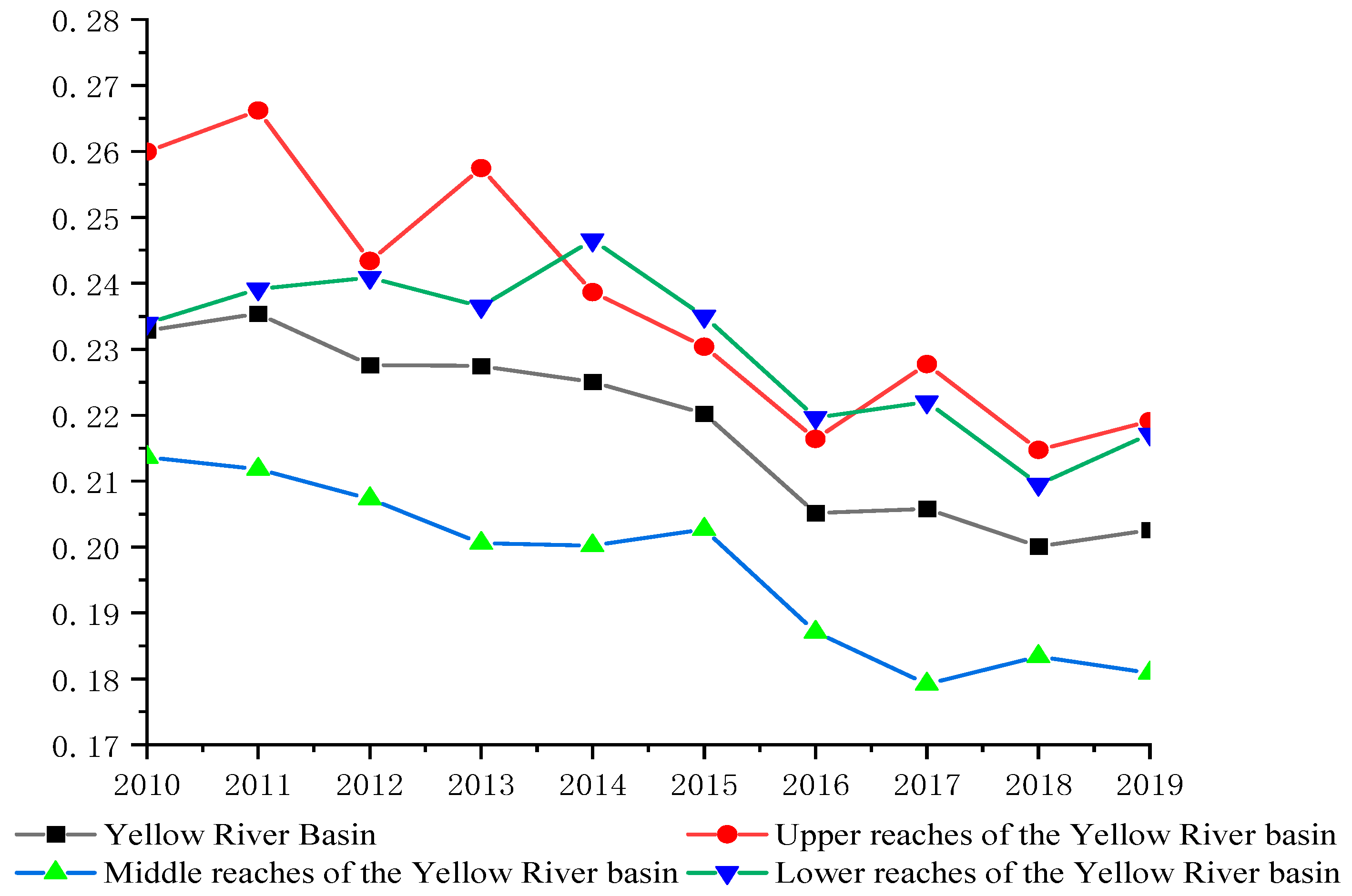

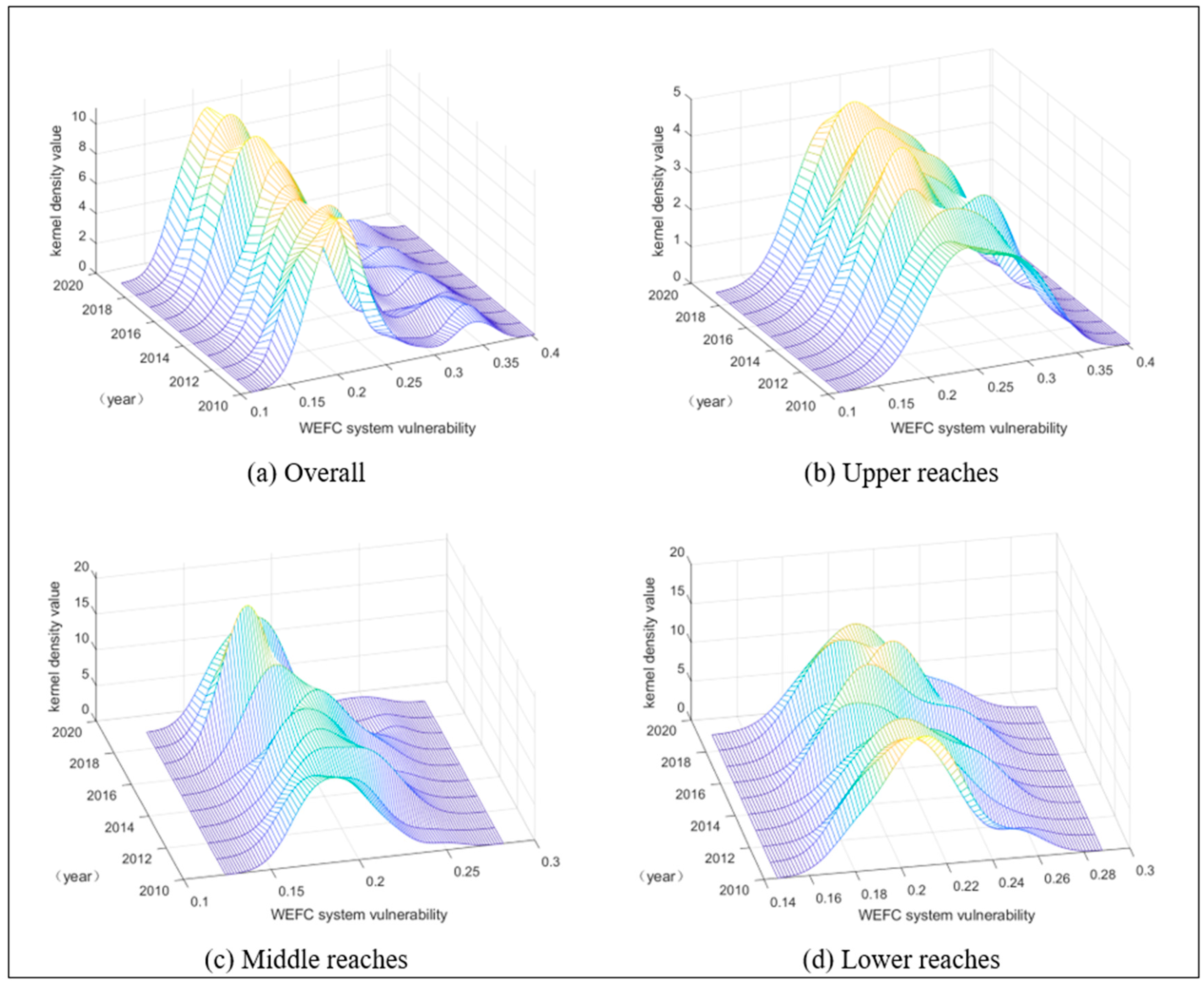
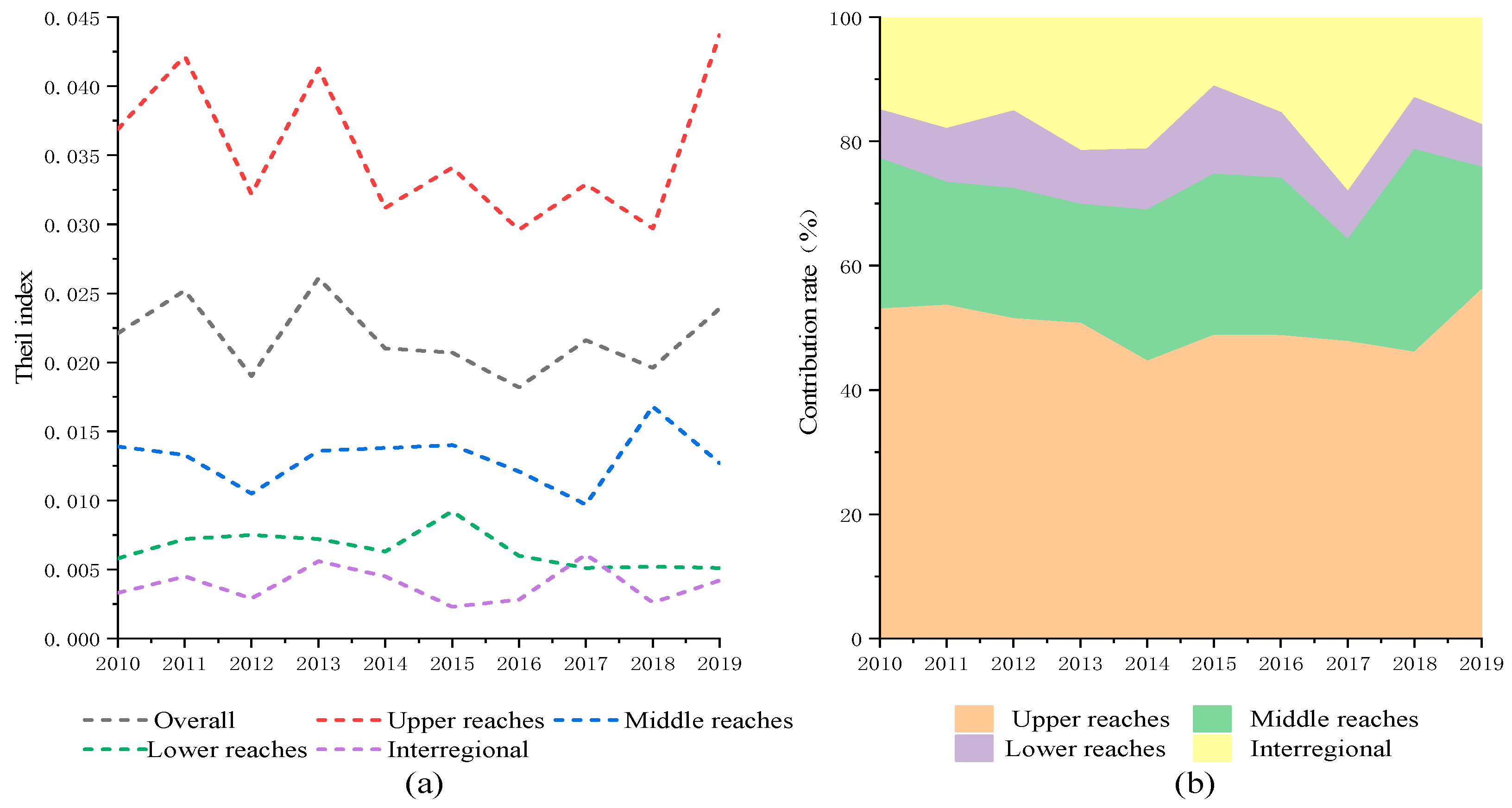

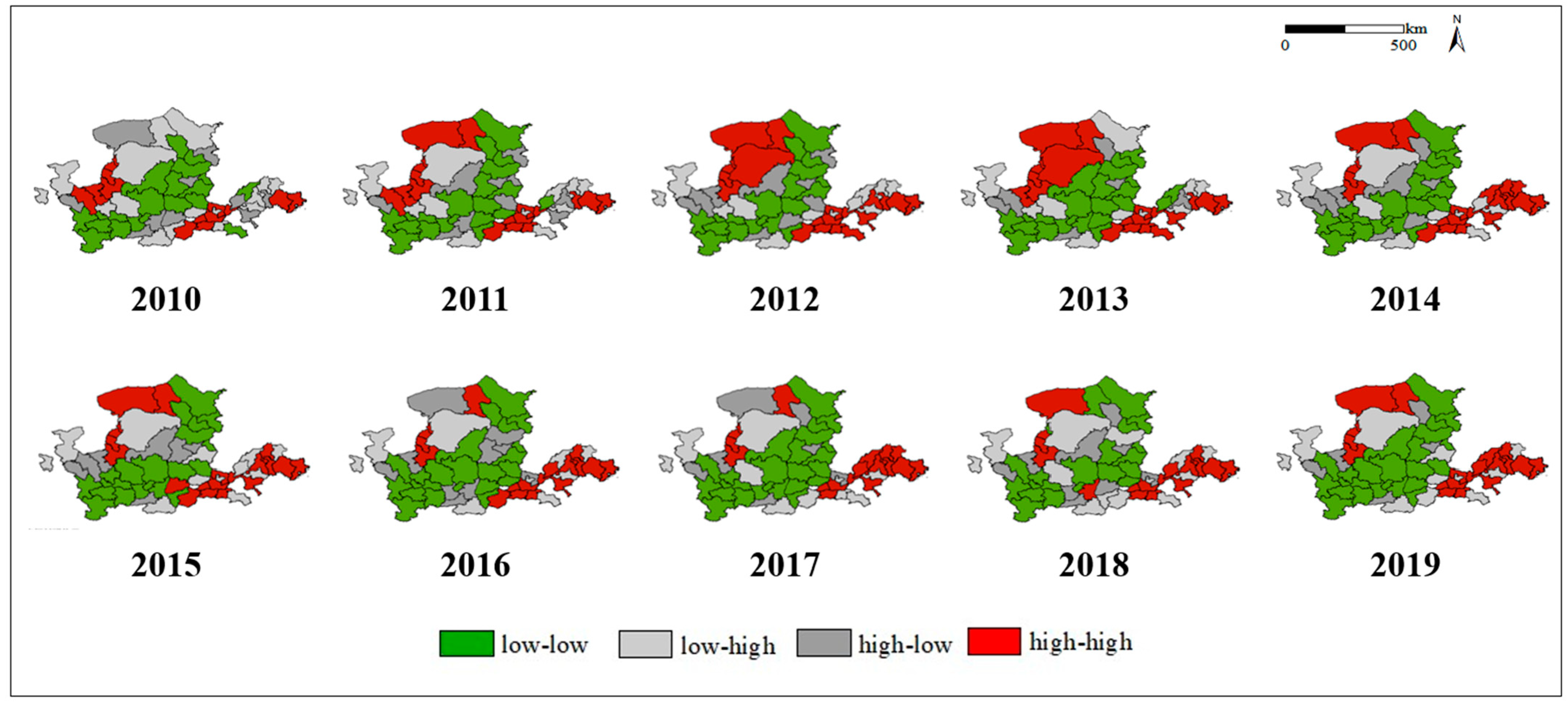
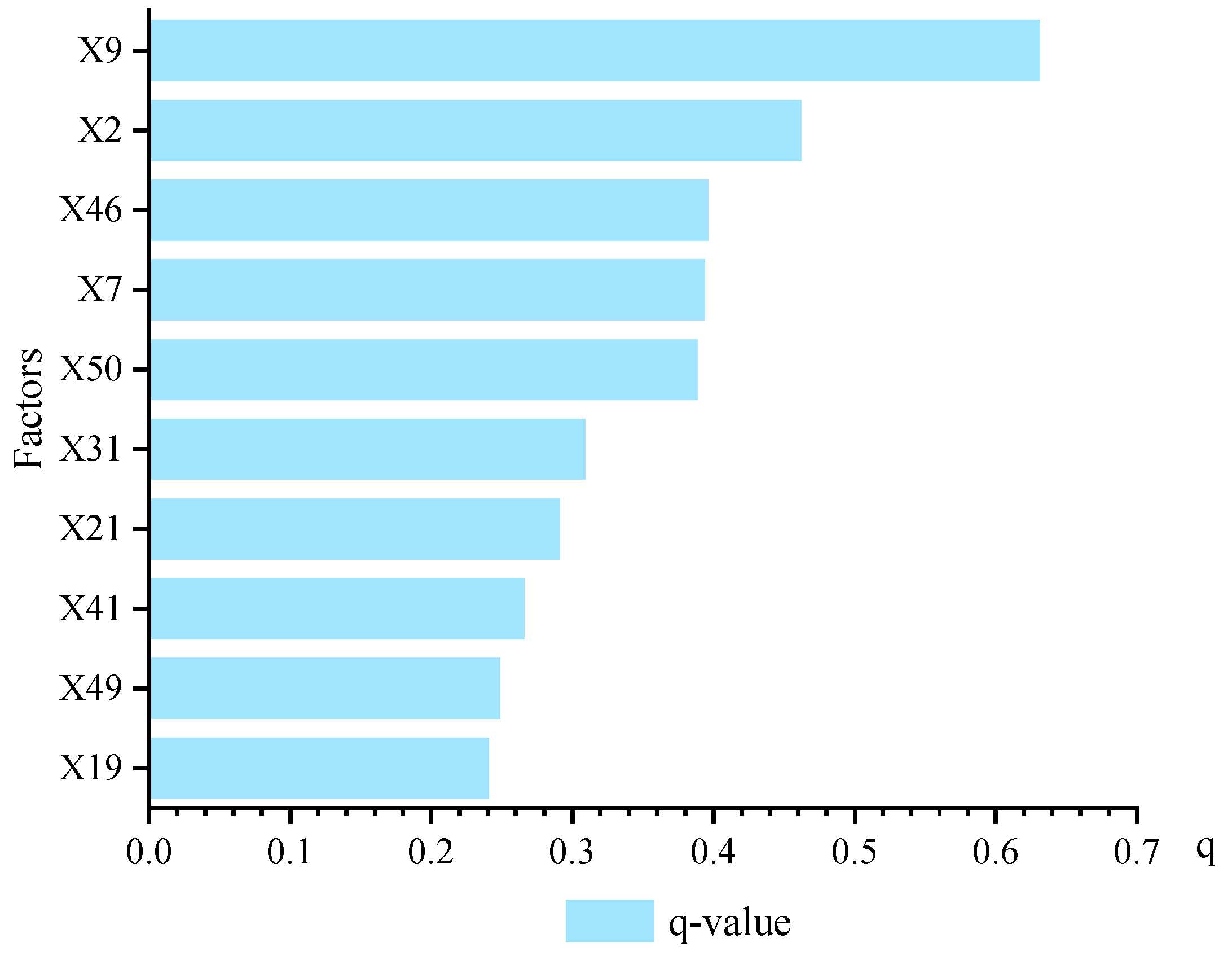
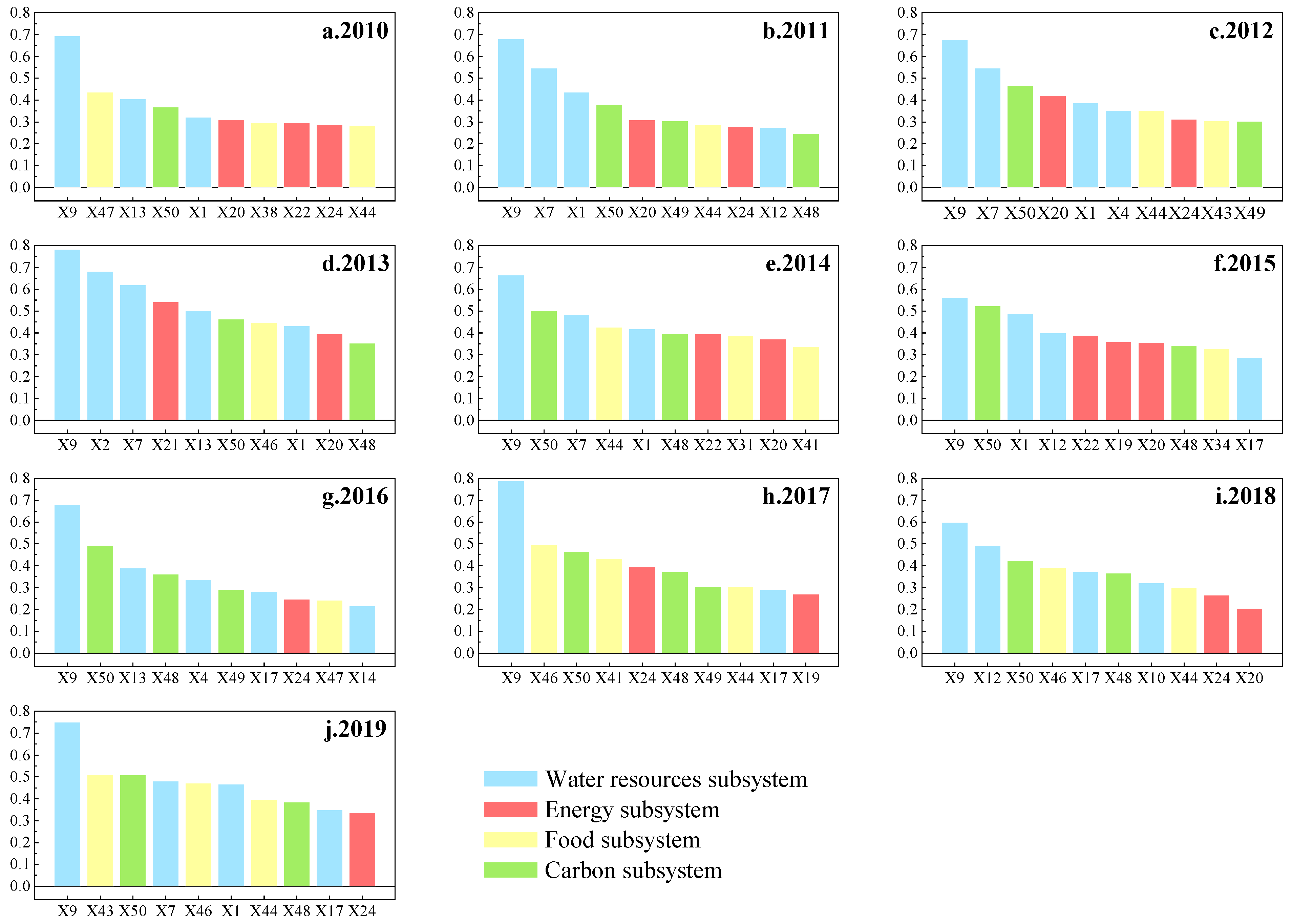


| Evaluation Index System | Impact | Mean | Max | Min | Std.Dev | |||
|---|---|---|---|---|---|---|---|---|
| Vulnerability of the WEFC nexus | Vulnerability of water subsystem | Exposure | X1 Urbanization rate (%) | + | 53.45 | 95.16 | 19.70 | 15.15 |
| X2 Per capita water consumption (cubic meters per person) | + | 376.37 | 3084.19 | 72.00 | 449.14 | |||
| X3 Ecological environment water usage rate (%) | − | 4.47 | 32.04 | 0.00 | 4.79 | |||
| X4 Wastewater discharge (10,000 cubic meters) | + | 8446.04 | 73,589.00 | 300.00 | 10,520.63 | |||
| X5 Reclamation rate (%) | + | 30.40 | 68.49 | 1.49 | 18.09 | |||
| X6 Population density (people per square kilometer) | + | 380.32 | 1440.37 | 17.53 | 305.99 | |||
| Sensitivity | X7 Population supported by one million cubic meters of water resources (person) | + | 5119.28 | 34,896.88 | 324.02 | 4412.65 | ||
| X8 Water production coefficient | − | 0.17 | 0.44 | 0.02 | 0.09 | |||
| X9 Water resources development and utilization rate (%) | + | 2.25 | 22.83 | 0.02 | 3.60 | |||
| X10 Water consumption per 10,000-yuan GDP (cubic meters) | + | 99.50 | 869.00 | 7.77 | 127.50 | |||
| X11 Average temperature change rate (%) | + | 0.56 | 31.28 | −12.07 | 5.29 | |||
| X12 Per capita GDP (yuan) | − | 50,062.12 | 256,877.00 | 5304.00 | 34,642.72 | |||
| X13 Precipitation (mm) | − | 531.24 | 8235.00 | 90.00 | 359.88 | |||
| Adaptability | X14 Sewage treatment rate (%) | − | 91.30 | 104.71 | 41.14 | 8.48 | ||
| X15 Green coverage rate in built-up areas (%) | − | 38.25 | 48.01 | 2.69 | 6.52 | |||
| X16 Per capita underground water reserves (cubic meters per person) | − | 104.71 | 1296.65 | −53.95 | 132.69 | |||
| X17 Artificial afforestation area (ha) | − | 15,099.45 | 104,143.00 | 182.00 | 13,498.78 | |||
| Vulnerability of energy subsystem | Exposure | X18 GDP proportion of secondary industry (%) | + | 49.53 | 73.71 | 15.60 | 11.49 | |
| X19 Industrial wastewater emissions (10,000 tons) | + | 5236.43 | 28191.00 | 48.00 | 5142.22 | |||
| X20 Industrial dust emissions (tons) | + | 34,116.77 | 260,939.00 | 450.00 | 38,296.66 | |||
| X21 Energy consumption intensity (ton standard coal per 10,000 yuan) | + | 0.09 | 0.91 | 0.01 | 0.11 | |||
| X22 Industrial SO2 emissions (tons) | + | 56,685.44 | 305,987.00 | 917.00 | 51,421.53 | |||
| Sensitivity | X23 Unit GDP energy consumption change rate (%) | + | 4.28 | 651.37 | −93.09 | 49.01 | ||
| X24 Energy self-sufficiency rate (%) | − | 63.65 | 1372.17 | 0.00 | 172.63 | |||
| X25 Per capita primary energy production (ton standard coal per person) | − | 13.32 | 273.31 | 0.00 | 33.57 | |||
| X26 Coal consumption proportion (%) | + | 78.04 | 99.62 | 0.00 | 16.69 | |||
| Adaptability | X27 Energy conservation and environmental protection expenditure (10,000 yuan) | − | 103,260.31 | 1,774,800.00 | 6000.00 | 121,959.48 | ||
| X28 Energy consumption elasticity coefficient | + | 2.05 | 267.74 | −102.21 | 14.11 | |||
| X29 Comprehensive utilization rate of general industrial solid waste (%) | − | 73.77 | 106.45 | 0.24 | 24.38 | |||
| Vulnerability of food subsystem | Exposure | X30 Urban registered unemployment rate (%) | + | 3.08 | 4.41 | 1.21 | 0.68 | |
| X31 Fertilizer application per unit sown area (kg/ha) | + | 438.15 | 2022.88 | 0.28 | 301.74 | |||
| X32 Labor force per unit of cultivated area (person/ha) | + | 2.16 | 10.68 | 0.48 | 1.19 | |||
| X33 Per capita arable land area (hectares per person) | − | 0.12 | 0.43 | 0.01 | 0.08 | |||
| X34 Per capita grain sown area (ha) | − | 0.10 | 0.24 | 0.01 | 0.05 | |||
| Sensitivity | X35 Engel Coefficient (%) | + | 29.85 | 45.17 | 20.41 | 4.33 | ||
| X36 Grain Total Quantity Volatility Rate (%) | + | 6.00 | 60.46 | 0.00 | 7.53 | |||
| X37 Proportion of grain sown area (%) | − | 0.74 | 0.97 | 0.00 | 0.12 | |||
| X38 Proportion of agricultural output value (%) | − | 9.97 | 30.58 | 0.79 | 6.59 | |||
| X39 Per capita grain possession (kg per person) | − | 499.19 | 1559.81 | 50.25 | 248.28 | |||
| X40 Expenditure on health and wellness (100 million yuan) | − | 26.14 | 115.19 | 3.42 | 18.01 | |||
| Adaptability | X41 Gross power of agricultural machinery per unit of sown area (kW/ha) | − | 7.50 | 23.88 | 0.00 | 3.33 | ||
| X42 Cultivated land replanting index | − | 2.56 | 729.06 | 0.63 | 29.72 | |||
| X43 Grain yield per unit area (kg/ha) | − | 5178.96 | 9102.84 | 1608.91 | 1541.22 | |||
| X44 Per capita disposable income of farmers (yuan) | − | 10,229.94 | 23,536.00 | 2299.00 | 3937.04 | |||
| X45 Investment in agriculture, forestry, and water conservation (100 million yuan) | − | 34.95 | 115.79 | 3.79 | 18.29 | |||
| X46 Effective irrigation rate (%) | − | 0.40 | 1.34 | 0.00 | 0.21 | |||
| X47 Education level | − | 49,375.09 | 330,373.00 | 117.00 | 51,917.19 | |||
| Vulnerability of carbon subsystem | Exposure | X48 Carbon emissions (million tons) | + | 35.77 | 121.13 | 5.20 | 20.28 | |
| Sensitivity | X49 Carbon sequestration (million tons) | − | 19.18 | 71.36 | 0.47 | 14.19 | ||
| Adaptability | X50 Carbon ecological carrying capacity coefficient | − | 1.46 | 16.12 | 0.03 | 2.22 | ||
| Criterion | Interaction Classification |
|---|---|
| Non-linear weakening | |
| Single-factor non-linear weakening | |
| Dual-factor enhancement | |
| Mutually independent | |
| Non-linear enhancement |
| 2010 | 2013 | 2016 | 2019 | ||||
|---|---|---|---|---|---|---|---|
| Driving Factors | q-Value | Driving Factors | q-Value | Driving Factors | q-Value | Driving Factors | q-Value |
| X9 | 0.694 | X9 | 0.784 | X9 | 0.681 | X9 | 0.750 |
| X47 | 0.436 | X2 | 0.681 | X50 | 0.493 | X43 | 0.512 |
| X13 | 0.405 | X7 | 0.620 | X13 | 0.388 | X50 | 0.510 |
| X50 | 0.369 | X21 | 0.541 | X48 | 0.360 | X7 | 0.481 |
| X1 | 0.321 | X13 | 0.503 | X4 | 0.336 | X46 | 0.473 |
| X20 | 0.311 | X50 | 0.464 | X49 | 0.291 | X1 | 0.468 |
| X38 | 0.296 | X46 | 0.448 | X17 | 0.281 | X44 | 0.398 |
| X22 | 0.296 | X1 | 0.432 | X24 | 0.246 | X48 | 0.386 |
| X24 | 0.288 | X20 | 0.395 | X47 | 0.243 | X17 | 0.350 |
| X44 | 0.285 | X48 | 0.353 | X14 | 0.216 | X24 | 0.337 |
Disclaimer/Publisher’s Note: The statements, opinions and data contained in all publications are solely those of the individual author(s) and contributor(s) and not of MDPI and/or the editor(s). MDPI and/or the editor(s) disclaim responsibility for any injury to people or property resulting from any ideas, methods, instructions or products referred to in the content. |
© 2024 by the authors. Licensee MDPI, Basel, Switzerland. This article is an open access article distributed under the terms and conditions of the Creative Commons Attribution (CC BY) license (https://creativecommons.org/licenses/by/4.0/).
Share and Cite
Tong, L.; Luo, M. Spatiotemporal Evolution Characteristics and Driving Factors of Water-Energy-Food-Carbon System Vulnerability: A Case Study of the Yellow River Basin, China. Sustainability 2024, 16, 1002. https://doi.org/10.3390/su16031002
Tong L, Luo M. Spatiotemporal Evolution Characteristics and Driving Factors of Water-Energy-Food-Carbon System Vulnerability: A Case Study of the Yellow River Basin, China. Sustainability. 2024; 16(3):1002. https://doi.org/10.3390/su16031002
Chicago/Turabian StyleTong, Lei, and Mengdie Luo. 2024. "Spatiotemporal Evolution Characteristics and Driving Factors of Water-Energy-Food-Carbon System Vulnerability: A Case Study of the Yellow River Basin, China" Sustainability 16, no. 3: 1002. https://doi.org/10.3390/su16031002
APA StyleTong, L., & Luo, M. (2024). Spatiotemporal Evolution Characteristics and Driving Factors of Water-Energy-Food-Carbon System Vulnerability: A Case Study of the Yellow River Basin, China. Sustainability, 16(3), 1002. https://doi.org/10.3390/su16031002






